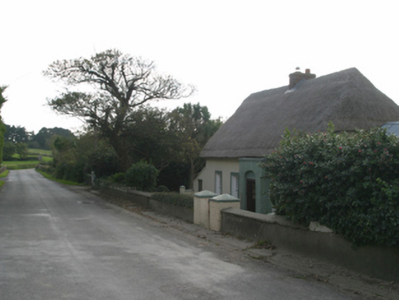Survey Data
Reg No
15704856
Rating
Regional
Categories of Special Interest
Architectural, Social
Original Use
House
In Use As
House
Date
1700 - 1840
Coordinates
310585, 108442
Date Recorded
23/10/2007
Date Updated
--/--/--
Description
Detached four-bay single-storey lobby entry house with dormer attic, extant 1840, on an L-shaped plan off-centred on single-bay single-storey flat-roofed windbreak; single-bay (single-bay deep) single-storey return (west). "Improved", pre-1903, producing present composition. Reroofed, 2005. Chicken wire-covered replacement hipped oat thatch roof with exposed hazel lattice stretchers to ridge having exposed scallops, red brick Running bond central chimney stack having stepped capping supporting terracotta pots, and exposed hazel stretchers to eaves having exposed scallops; pitched slate roof (west) with clay or terracotta ridge tiles, lichen-spotted rendered coping to gable with rendered chimney stack to apex having corbelled stepped stringcourse below capping, and cast-iron rainwater goods on exposed timber rafters retaining cast-iron downpipes. Fine roughcast battered walls; rendered surface finish (west). Square-headed off-central door opening in elliptical-headed recess with concealed dressings framing glazed timber panelled door. Square-headed window openings with concrete or rendered sills, and rendered "bas-relief" surrounds framing two-over-two timber sash windows having part exposed sash boxes. Square-headed window openings (west) with concrete sills, and rendered "bas-relief" surrounds framing two-over-two timber sash windows. Road fronted in slight hollow with fine roughcast piers to perimeter having shallow pyramidal capping supporting wrought iron gate.
Appraisal
A house identified as an integral component of the vernacular heritage of south County Wexford by such attributes as the rectilinear lobby entry plan form off-centred on a characteristic windbreak; the construction in unrefined local materials displaying a battered silhouette with sections of "daub" or mud suggested by an entry in the "House and Building Return" Form of the National Census (NA 1901; 1911); and the high pitched roof showing an oat thatch finish replenished with the financial assistance of a grant (2005) from The Heritage Council: meanwhile, aspects of the composition clearly illustrate the continued development of the house in the later nineteenth century with those "improvements" showing a "permanent" slate finish. Having been well maintained, the elementary form and massing survive intact together with substantial quantities of the original fabric, both to the exterior and to the interior, thus upholding the character or integrity of a house making a picturesque visual statement in a rural street scene.





